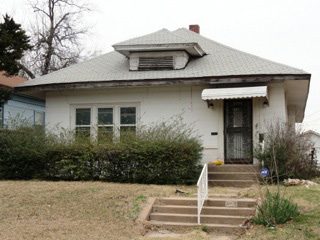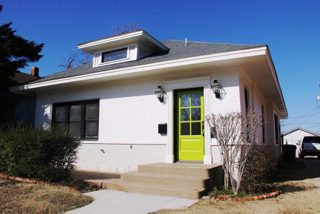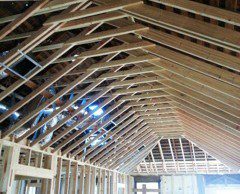In Oklahoma City, builder John Beedon, owner of Beehold Reinventions, recently purchased a 1910 home in Mesta Park, a neighborhood listed on the National Register of Historic places and designated a Historic Preservation District by the City of Oklahoma City.
Beedon has been passionate about sustainable building for years, but combining that practice with the specific requirements and restrictions of remodeling in a historic preservation area requires a special commitment. Any changes to the front of the home have to be approved.

Although it wasn’t Beedon’s intention to get the house certified, he is knowledgeable of the various tax credits available for certain energy efficiency changes as well as historical preservation projects. Beedon feels that using sustainable methods in building is the right thing to do – from recycling waste materials to using repurposed materials to creating the most energy efficient residence possible.
The previous owner had planned to remodel the house but had to sell it before completion.
“The house had been stripped to the studs when I bought it,” says Beedon.
It was obvious that there had been many changes over the years that were not historical, from the aluminum awning over the front door to the heavy wrought iron security door. Unfortunately, the original front door was gone.
Beedon removed the awning and replaced the front door with a used, energy efficient, solid wood door that he found at Habitat for Humanity.
“I’m not so sure everyone likes the color,” laughs Beedon.
He planned to paint the windows black because that would have been typical of the old farmhouse style, and as they worked through layers of old paint, he discovered that black had indeed been the original window color.

Photos courtesy John Beedon.
Inexpensive light fixtures hung on either side of the door, in the place of the originals. Beedon chose a lantern-style fixture to restore a more historic look. He installed a new mailbox to the left of the front door, opposite of the original box on the right that is equipped with dials for the family to leave the milkman their order.
“One of the first things we discovered was there were five layers of asphalt shingles over the original cedar roofing,” says Beedon.
He estimates those shingles added up to about 50,000 pounds more than the house was structurally built to support. After removing the existing roofing materials, the new roof was covered with asphalt shingles from the roofing options approved for the historic neighborhood.
The house was constructed from unique T-shaped concrete blocks that even the most experienced local contractors haven’t seen before. Because of that, there is some speculation that this might be one of the first concrete block homes built in Oklahoma City.
“For aesthetics and historic preservation requirements, we rebuilt the windows, most of which still had the original glass,” he says.
Beedon has perfected a process for making the vintage double hung windows energy efficient. He takes the casing off, removes the ropes, pulleys and counter weights then fills the cavities with backing and spray foam insulation. He then adds two sets of sash springs per operable window to make the windows fit tight and limit air intrusion.
“I love the shadows cast in the room from the irregularities in the old glass panes,” he says. “My goal is to keep as much of the historic elements as possible while making the space more efficient.”
The layout of the house was typical of a bungalow style at the time. One side of the house was divided into three rooms – the living room, dining room and the kitchen. An angled fireplace in the living room was not structurally sound, so it was removed along with the walls, making one large area with a 13-foot ceiling.
Beedon worked alongside Jarod Tracy and John Butti during the design and construction.

“They are craftsmen often working within the constraints of existing conditions, who come up with solutions mindful of energy efficiency and the efficiency of space,” says Beedon.
Originally it was three bedrooms with only one bathroom.
“And the front bedroom was eight feet by 14,” says Beedon. “Not very usable.”
So, along with reworking some interior walls, he used the space just inside the front door to create a second bathroom. The old dormer attic vent, visible on the front of the house, was converted to a window that provides the bathroom with some natural light.
The original doors were found in the garage along with the original hardware that he is restoring. Because old closets were typically small, custom armoires were built in the closet niches that go up to the nine-foot ceiling. The original pine flooring wasn’t usable, so a layer of insulation was added and then a hardwood floor installed.
A tankless water heater was used since it is both energy efficient and takes up much less space, an important factor when working with 1,297 square feet. And while the exterior walls are energy efficient concrete block, foam insulation was used in the attic space. An oversized heating and cooling unit was installed because of the vaulted ceilings.
“Even the best energy efficient system won’t be efficient if it has to run all the time,” says Beedon.
Many homeowners assume using sustainable building methods will be substantially more expensive, and while some initial investments might be somewhat higher, the payoff in lower energy costs is just one of the advantages. According to Immel, in a remodel or when building a new home, it could just be a matter of cost shifting – looking at all the costs of the project to see if making a little higher investment in one area could save money on utility bills in the future. There are many sustainable green building alternatives available to consumers that have little or no additional out-of-pocket upfront costs, like ENERGY STAR cool roof asphalt shingles and energy efficient vinyl windows. Also for a minimal investment, the collection of rainwater, also known as ‘rainwater harvesting’ can be used to water lawns and gardens.
When Immel moved back to Tulsa in 2008, he found that the market for green building was behind what he had experienced in Denver. So he and a friend built the first family LEED certified home in Tulsa’s Brookside area. And while everyone might not respond positively to products promoted as being ‘environmentally friendly,’ there is a big interest in saving on utility bills.
“I try to help homeowners understand the long term benefit of investing in energy efficient products from the heat and air system to appliances,” says Immel, since the average household spends at least $2,000 a year on energy bills.
Another big consideration for green building is for health and wellness purposes.
“Most people don’t realize how their home could be affecting their health,” says Immel.
A home could be drafty or the air quality not optimal if the ductwork isn’t properly sealed and is drawing air from an attic or crawlspace. Using low or zero VOC paints, such as those manufactured by Tulsa’s Anchor Paint, is a good choice to improve interior air quality. And if you are unsure if a product is really green, check for third-party certification standards.
























